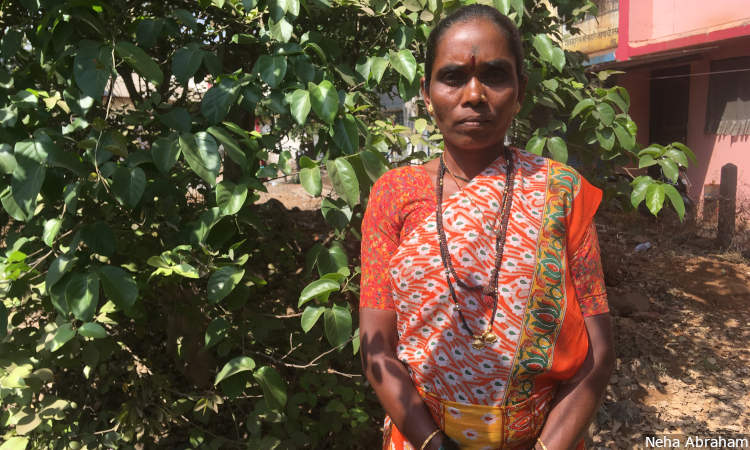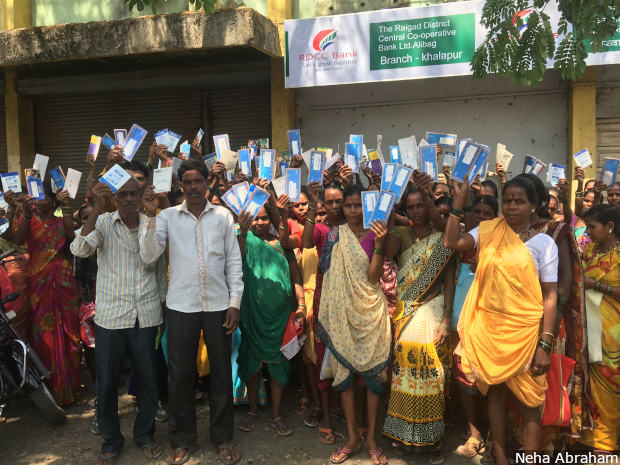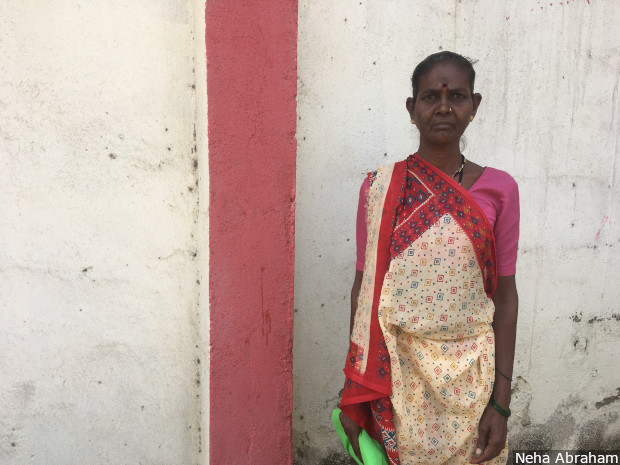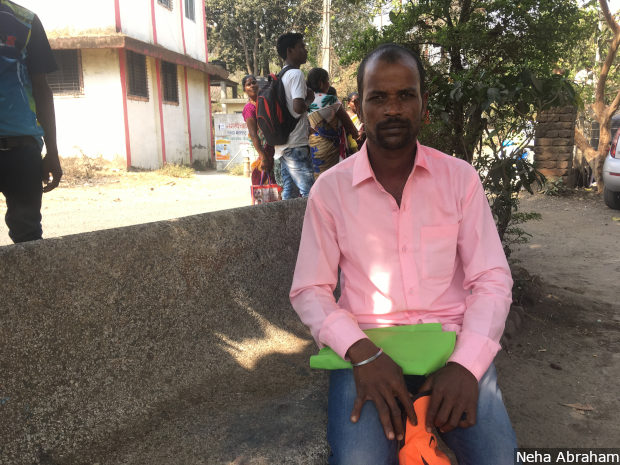Financial Inclusion Low Despite 356 Mn Jan Dhan Accounts

“I opened this account because it was free and we would get Rs 5,000 with it,” says Kantha Mukhne, 40, referring to her Jan Dhan account and the overdraft facility that comes with it. Four years since, she keeps her savings at home--like millions of Indians for whom banking remains out of reach.
Raigad, Mumbai: When word of “Modi khata” spread at Kelavali village in Maharashtra’s Raigad district, 40-year-old Kantha Mukhne walked 10 km one muggy morning in July 2015 to open her first bank account, under the Pradhan Mantri Jan Dhan Yojana. Paddy sowing was at its peak, but Mukhne gave up a day’s work to visit the Raigad District Central Co-operative (RDCC) Bank at Khalapur town, 65 km south-east of Mumbai.
Mukhne and her husband are Katkaris--one of three main adivasi (tribal) communities in the Konkan region, most of whom find work as daily wage farm labour. The couple make Rs 200-Rs 250 a day, just enough to feed their three children. A bank account seemed useless until then.
“I opened this account because it was free and we would get Rs 5,000 with it,” she told FactChecker.in one afternoon in April 2019, referring to the overdraft facility provided with such accounts. This was telling of misinformation surrounding the scheme.
Mukhne’s is one of 356 million no-frills accounts (as of May 1, 2019) opened under the Pradhan Mantri Jan Dhan Yojana (PMJDY). Yet, four years since that July morning, she does not know how to use her account and keeps her savings at home.
She is not alone. As many as 52% of respondents in the All India Rural Financial Inclusion Survey, 2016-17, conducted by the National Bank for Agriculture and Rural Development (NABARD), said they prefer to keep their savings at home.
Mukhne has not deposited any money after two initial transactions--she was told to deposit Rs 100 at the time of opening, and another Rs 500 a few months later. “Why did I have to give Rs 600 if it was zero balance?” she asked, expressing her mistrust of banking services.
Further, only 11% respondents had “good” financial literacy, defined as a combination of sound financial knowledge, positive financial attitude and behaviour, as per the NABARD study cited above--referred to as NAFIS and conducted between January and June 2017.
PMJDY, launched by the National Democratic Alliance (NDA) government in August 2014, added steam to processes under way as part of the Reserve Bank of India’s (RBI) roadmap for phased financial inclusion.
India’s banked population more than doubled from 2011 to reach 80% by 2017, and by 2018, 66% of about 536 million no-frills accounts were Jan Dhan accounts.
Yet, having an account does not amount to being financially included. The PMJDY’s goal of “comprehensive inclusion of India’s unbanked population” rests on six pillars: universal access to banking facilities, an overdraft and RuPay Debit card to all households, financial literacy programmes, credit guarantee fund, micro insurance and pension schemes.
These accounts are also part of a larger shift in welfare delivery. Jan Dhan is the ‘J’ in the ‘JAM Trinity’--along with Aadhaar, a unique biometric identification number, and Mobile banking--through which the government aims to deliver direct cash transfers to beneficiary accounts.
However, account usage, financial literacy, savings and institutional borrowing have shown little improvement, data from the Reserve Bank of India (RBI) show.
As many as 15% of accounts were zero-balance as of January 23, 2019, according to data submitted to the Rajya Sabha by the finance ministry, although this has dropped from 25% in 2016 and 75% in 2014. Further, 84% accounts are still only ‘operative’--that is, they have seen at least one transaction in the last two years--according to government data submitted to the Rajya Sabha in January 2019.
Source: Reserve Bank of India, Pradhan Mantri Jan Dhan Yojana website
This is the 13th story in our ongoing FactChecker series on the NDA government’s flagship programmes. The first investigated the government’s rural-jobs programme (here, here and here); the second discussed the Swachh Bharat (Clean India) Mission’s sewage problem; the third (here, here and here) evaluated the Pradhan Mantri Sahaj Bijli Har Ghar Yojana (Prime Minister’s electricity-to-all-homes programme); the fourth, the fudging of open-defecation-free (ODF) status data and shoddy toilet construction in Uttar Pradesh, which was declared ODF on December 31, 2018; the fifth, similar fudging of data and widespread open defecation in Gujarat, declared ODF on October 2, 2017; the sixth explained how the skills-development mission was set to miss deadlines; the seventh probed the failures of the Prime Minister’s crop-insurance programme; the eighth the failure of BharatNet, the project to connect India’s villages to the Internet; the ninth on why the Namami Gange project to clean up the Ganga river is failing; the 10th on how the cooking-gas programme is welcome but too expensive; the 11th on the urban housing scheme; and the 12th on the rural housing scheme.
Lured by overdraft facility, left confused and wanting
An overdraft facility of Rs 5,000 was offered to accounts with regular transactions for at least six months. Many Katkaris lined up at the bank that July, assuming this was free money.
Added to this were rumours of how Prime Minister Narendra Modi had launched the scheme to deposit Rs 15 lakh of returned or confiscated black money into these accounts--following his election campaign promises, and speeches during demonetisation--when 86% of India’s currency, by value, was invalidated overnight in November 2016.
The overdraft facility has been availed by no more than 1% of account holders--that is 3.17 million of 340 million accounts as of January 2019--according to data submitted by the government to Rajya Sabha. Part of the explanation lies in the required active usage. Those who need the overdraft facility are unlikely to save and have regular transactions.

Account holders display their passbooks at the Raigad District Central Co-operative Bank in Khalapur town of Raigad district near Mumbai in Maharashtra. Back in July 2015, many tribals from Kelavali and Nadode villages of the district rushed to open bank accounts, after rumours that Rs 15 lakh of returned black money would be deposited into each account.
In Mukhne’s case, no one told her what an overdraft was and how she could use it.
Average financial literacy scores in India are low--at 11.9 out of 21 as calculated in data submitted by the finance ministry to the Rajya Sabha in January 2019. Financial literacy was defined as a combination of financial knowledge, attitude and behaviour.
This is probably because only 10% of Indians have attended any financial information sessions between 2014 and 2017--9.4% in rural and 13.2% in semi-urban areas.
“The RBI has issued circulars to the banks expecting they would conduct these [financial literacy programmes],” said Anirudha Mirikar, director, Sampada Entrepreneurship and Livelihoods Foundation, a microcredit non-profit. “Banks, however, do not have the manpower, or expertise.”
This is despite a 126% rise in financial literacy activities between March 2014 and March 2018, according to RBI data.
Source: Reserve Bank of India
Most Katkaris were signed up for various schemes without knowledge or consent, because of pressure on the banks to reduce the number of inactive and zero-balance accounts.
“We open accounts at Rs 500. Some people can’t afford it, so we open it as Rs 100 also,” explained B.C. Patil, branch manager, RDCC Bank. “Who will pay Rs 12 premium for accident insurance, otherwise?”

Anasuya Waghmare, 45, a Katkari woman from Nadode village in Raigad district’s Khalapur, takes a 20-minute autoride to the bank every month to check if any money has been credited to her account. After the initial Rs 100, she has not deposited any money.
“When you do bring such people in, you can’t whack them with higher costs because that will only mean that they will not end up using it, exactly like they are not using the second cylinder in Ujjwala,” said Jayati Ghosh, professor of economics at the Centre for Economic Studies and Planning at the Jawaharlal Nehru University, New Delhi. She was referring to the Pradhan Mantri Ujjwala Yojana that gave connections and one free cooking-gas cylinder to below-poverty-line households, but has failed to encourage people used to free firewood to switch to relatively expensive cooking gas, as IndiaSpend reported on April 30, 2019.
Operational glitches are also part of the problem. As of January 23, 2019, 271 million RuPay cards with an inbuilt Rs 1 lakh accident insurance cover have been issued to beneficiaries, the government told Rajya Sabha in February 2019. But this does not mean that these individuals actually have cards. None of the Katkaris we spoke to had cards.
Once issued, RuPay cards are either sent to customers via courier or to banks for distribution. Long distances and rudeness deter low-value PMJDY customers from visiting branches, this December 2015 assessment of the scheme by Microsave, a financial inclusion consulting firm, found.
Banking infrastructure lags behind
A key reason for the low level of the deposits/credit in rural areas has been poor access to banks, according to the India Exclusion Report 2017. This is due to the banks’ reluctance to set up brick-and-mortar structures in sparsely populated regions, because they are economically unviable.
Between March 2014 and March 2016, 5,704 new branches have been set up in villages; by March 2018, 1,025 of these were shut, data from the RBI show.
Source: Reserve Bank of India
India’s banked population is the highest among BRICS nations, equal to China’s. However, it lags behind on different inclusion indicators, data from the International Monetary Fund and World Bank show.
ATM (automated teller machine) density, per 100,000 adults, is low at 22.07. This is a quarter of China’s, a fifth of Brazil’s, less than a seventh of Russia’s, and a third of South Africa’s.
Source: International Monetary Fund, Global Findex Data
Note: Data as of 2017
This could be one reason why only 24% respondents had availed ATM facilities in the three months preceding the NAFIS study.
The possibility of mobile banking is also distant. Kaluram Waghmare, 35, a Katkari from Nadode village, rolled his eyes at the mention of mobile banking. He drew out his phone to reveal that it is not ‘smart’.
No more than 5% Indians had used mobiles or the Internet to access a financial institution account, and only 29% had made or received digital payments in 2017, World Bank data show.
Business correspondents ineffective, cross-subsidising necessary for inclusion
Business correspondents or bank mitras--usually a person or institution providing services on behalf of banks--have been promoted for last-mile access as banks cut costs.
None of the Katkaris that FactChecker spoke to knew of a business correspondent.
As of January 2019, 126,000 business correspondents were deployed. Yet, 425,000 of India’s 605,468 settlements remain uncovered, RBI data show.
Business correspondents have been successful in increasing enrolments: 80% of the customers came to know about PMJDY through a correspondent, the MicroSave study found.
They were also the preferred choice over ATMs and bank branches for 70% of customers. Four in five (79%) respondents said this was because of proximity, 51% cited ease of transaction, and 34% cited more convenient working hours.
Yet, only 59% correspondents said they had been adequately trained--compared to 89% in Kenya, 94% in Uganda and 69% in Bangladesh--according to the MicroSave study.
“Many banks have hired local kirana [provision] shops owners to be business correspondents, and there are hardly any capacity-building measures in place,” Mirikar told FactChecker. “Often they don’t know how to operate a computer or the biometrics machine.”
Correspondents also have little incentive to inform customers or encourage transactions. “For each transaction, the correspondents get a very small amount,” said Mirikar. “Banks are not insisting on bringing good customers who will maintain a balance, take loans, or remittances or pension schemes. So what’s the point?”
Bank mitras thus tend to open accounts to maximise their commission income and this has partly contributed to 33% accounts being duplicates, according to the MicroSave report. There have also been reports of beneficiaries being exploited.
Experts said that such a model is likely to fail because it is targeted at the low-income segment. “Any model which has to be scalable out of its own remuneration will fail,” said Dipa Sinha, assistant professor, economics, at Ambedkar University. “There is no demand for financial services and that is when you need government interventions.”
While the costs of financially including customers who are poor, illiterate and at distant locations are higher, economists recommend “cross subsidising”.
“The banks actually have higher costs and we can’t pretend that there aren’t any,” said Ghosh. “But we have to decide to take from the benefits you are getting from other accounts to expand here. You have to recognise the higher costs. You can’t simply farm it off to business correspondents either.”
Without jobs, no demand for financial services
In recent years, finding work has become harder for the Katkaris, which directly impacts people’s ability to save. An estimated 32 million casual labourers lost jobs in rural India between 2011-12 and 2017-18, The Indian Express reported on April 24, 2019, citing data from the Periodic Labour Force Survey (PLFS) 2017-18 report by the National Sample Survey Office. (Read IndiaSpend’s series on job losses in the informal sector precipitated by demonetisation in 2016 and the transition to the Goods and Services Tax from 2017 reported from: Indore, Jaipur, Perumbavoor, Ahmedabad, Kolkata, Lucknow, Bengaluru and Bathinda.)
As a result, 20% of women and 18% men without accounts said they did not have the money to make any transactions, while 16% women and 12% men said they did not feel they needed one, according to the 2017 Financial Inclusion Insights survey.
Access to credit, as we said, is one of the stated goals of PMJDY. Yet, of the 48% respondents who needed a loan in the NAFIS study, 76% sought it from non-institutional sources because of “easy availability”. Of these, 25.3% said loans could be availed for all kinds of purposes from such sources, 34.9% said it helped avoid excessive collateral requirements, and 47.9% said they did not want to deal with a lengthy application process.
Local community dynamics perpetuate financial exclusion
The RDCC bank in Raigad district’s Khalapur town has used connections with panchayat samitis (rural governing bodies) for outreach. “Most employees are locals, so we have good connections in villages and with the panchayat samiti,” explained Patil, the branch manager.
The Katkaris FactChecker spoke to insisted that while they were all told to open accounts by the dominant Maratha leaders in the samiti, information about other facilities, especially loans, is usually withheld.

Kaluram Waghmare, 35, is a daily wage farmhand from Nadode village in Raigad district in Maharashtra. When he needs to borrow money, he prefers to borrow from relatives. The Maratha heads of the panchayat samiti seldom share information about loans with Katkaris, he said.
Dominant upper castes hold significant influence in cooperative banks and often determine lending patterns, revealed a 2013 study by Sunil Kumar, a lecturer in economics at the India Institute at King’s College, UK, published in Ideas for India, a policy research website.
The numbers tell a similar story. Non-indebtedness levels were highest amongst scheduled tribes households at almost 63.7%, more than scheduled castes households at 49.80%, as the Rangarajan Committee highlighted in its report on financial inclusion using data from the 59th round of the National Sample Survey.
Aadhaar-related glitches hinder direct transfers
PMJDY, as we said, is a part of the JAM trinity that the government uses for direct benefit transfers. While an Aadhaar is not mandatory to receive transfers, it continues to be a relevant document for disbursal of welfare payments.
As many as 83% of PMJDY accounts are linked to Aadhaar. While 440 schemes are being implemented in the direct benefit transfer mode, only 23% of Jan Dhan accounts have received such transfers as of August 2018, according to this reply to the Rajya Sabha on February 12, 2019.
Linkages with Aadhaar have also led to a range of issues such as ‘rejected payments’ (e.g., due to wrongly seeded Aadhaar numbers), ‘redirected payments’ (due to the last-Aadhaar linked-account rule (the system automatically transfers money to the account that was linked last, in cases where beneficiaries have multiple Aadhaar-linked accounts)), and ‘frozen accounts’. All these lead to decreased account usage.
Back in Kelavali village, four years since she first got her account, Mukhne has no inclination to explore banking facilities. “Five years ago, we didn't have money, so we never even thought of going to a bank. We still don’t have money. So what will we do there now?” she asked.
However, unlike before, the bank which had seemed intimidating is a space she is now familiar with. For her, this is the scheme’s prime achievement: “Before, we didn’t go to the bank; now many Katkaris do--even if only to check if Modi has given them Rs 15 lakh.”
(Abraham is an intern at IndiaSpend and FactChecker.)
We welcome feedback. Please write to respond@indiaspend.org. We reserve the right to edit responses for language and grammar.



